|
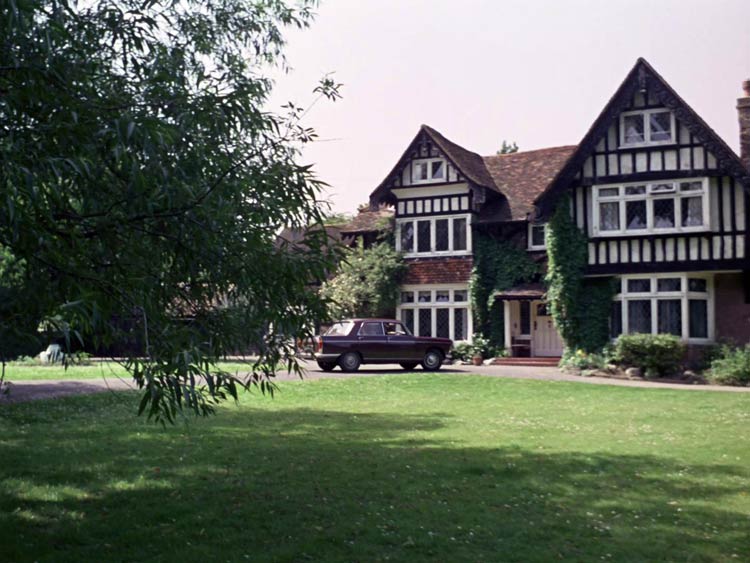
Image © ITV Studios,
1968
The
filming location for Arthur de Crecy's country
cottage from But What A Sweet Little Room
proved nearly impossible to track down and we now
know why: it was completely demolished in the early
1970s and
there are few visual clues remaining today to
suggest that it had ever existed. Consequently, it
was for many years one of the great undiscovered ITC
filming locations, and one which most location
spotters were convinced really was somewhere nestled
deep in the English countryside. However, when it
was located by Alan Hayes in March 2012, albeit many
long years on from its destruction, it was
pinpointed in environs of a rather more suburban
nature - indeed it was only a short distance from
the film studios in Borehamwood, and a stone's throw
from the shops on Shenley Road!
|
ITC Productions filmed at 'Ewhurst Manor':
Gideon's Way - 'Boy With Gun' (filmed May 1965)
The Baron - 'Portrait of Louisa' (September 1965)
The Champions - 'The Final Countdown' (early 1968)
Randall and Hopkirk (Deceased) -
'But What a Sweet Little Room' (Summer 1968)
Jason King - As Easy As A.B.C. (1971
- stock footage) |
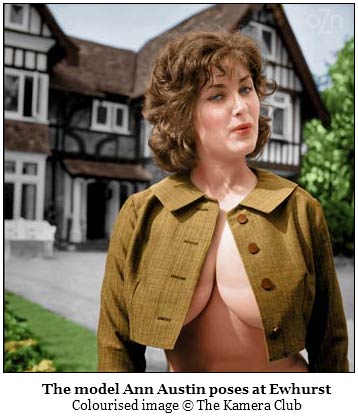 As
noted above, 'Ewhurst Manor', 37 Furzehill Road, Borehamwood was
used in four ITC productions as a filming
location, but it has been revealed to have had a
sleazier side, being a
favoured location for the photographing of young
ladies in various states of undress and the filming of
'glamour' films by a variety of photographers and
film makers, the most famous being George Harrison
Marks. American glamour photographers including Earl
Leaf and Irv Carsten also found their way to this
haven of olde worlde English charm to focus their
lenses on a parade of nubile young women. As
noted above, 'Ewhurst Manor', 37 Furzehill Road, Borehamwood was
used in four ITC productions as a filming
location, but it has been revealed to have had a
sleazier side, being a
favoured location for the photographing of young
ladies in various states of undress and the filming of
'glamour' films by a variety of photographers and
film makers, the most famous being George Harrison
Marks. American glamour photographers including Earl
Leaf and Irv Carsten also found their way to this
haven of olde worlde English charm to focus their
lenses on a parade of nubile young women.
The owner of the house, Mrs Doris Clifford
was reputedly a great
champion of Marks' endeavours and he filmed many 8mm
movie shorts and staged numerous photographic
glamour shoots at the manor house. The films included
Nightmare at Elm Manor (1963), Photo Session
(1963) and Visit from
Venus (1964) and the glamour photography
involved models such as Margaret Nolan (under the
pseudonym Vicky Kennedy), June Palmer and Vivienne
Warren. Mrs Clifford encouraged film
makers to use her property and she would make a
'nominal charge' for filming and photographic
sessions. She and her husband Alec were separated
but he remained at the house for six months of the
year and reputedly gave his wife a free hand to
engage in her lucrative sideline. Apparently, the
regular appearance of a series of attractive, naked young women
in the house and grounds did not
inconvenience him particularly!
Desperately Seeking Doris
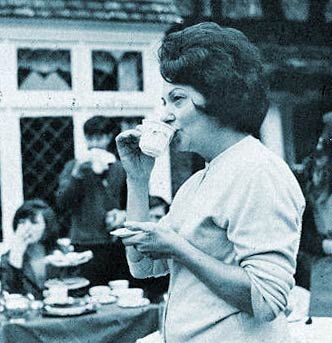
Doris Clifford at Ewhurst Manor
Image © The Kamera Club, 1964
The information we
have concerning 'Ewhurst Manor' and Doris and Alec Clifford has,
until recently, been sourced from two 1960s articles
in American adult glamour magazines – Caper and Hi Life. Having read these
articles it occurred to me that, considering the
nature of such publications, the Clifford name may
have been a pseudonym used in the piece.
However, pleasingly, we have now been able to confirm
the Cliffords' identities from telephone directories
of the era: Alec Clifford – and therefore Doris – was recorded as being
resident at 37 Furzehill Road from 1958 to 1970 (and
their telephone number was ELStree 1096, trivia fans).
The only thing that may be an invention for the
articles is the Ewhurst Manor name itself, and until
we are able to confirm this either way there must be
at least some doubt that the building ever really went
by this name. It is entirely possible that the name
was concocted as a cover to shroud the property's
actual location from prying eyes (both articles also
suggest that Ewhurst was "an estate" in Elstree, a
village some two miles from Borehamwood). Also the
authorities took a dim view on such illicit, improper
activities, so in many ways it really did pay not to
advertise too boldly. Besides, the name 'Ewhurst
Manor' affords significantly more mystique than '37
Furzehill Road'!
The magazine articles reveal how the
Cliffords' odd enterprise came into being: "This all
began quite by chance. Mrs Clifford's husband, a
sweater manufacturer, was having some advertising
photos made and invited the photographer taking them
to use the house as a site. The lensman accepted and
was so impressed, he asked to use the manor several
times thereafter. It wasn't long before word of
Ewhurst spread locally, and the Cliffords were flooded
with calls from cameramen requesting location
privileges. As a result, Mrs Clifford came up with the
idea of charging a reasonable fee and opened the house
to all cameramen." (Hi-Life, April 1964)
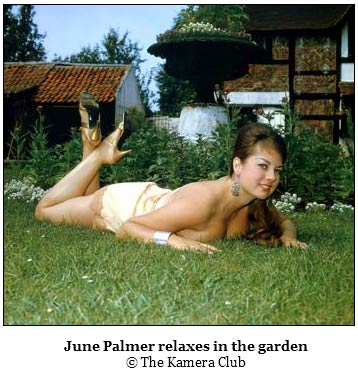 "[The
Cliffords] soon became accustomed to the intent young
lensmen who swarmed about the house and grounds,
snapping hundreds of photographs of their pretty
models who might be sitting on the lawn in a bikini,
peeping from behind a stately oak tree or simply
relaxing during a break, smoking a cigarette in the
drawing room while the photographer puts fresh film in
his trusted camera." (Caper, 1964) "[The
Cliffords] soon became accustomed to the intent young
lensmen who swarmed about the house and grounds,
snapping hundreds of photographs of their pretty
models who might be sitting on the lawn in a bikini,
peeping from behind a stately oak tree or simply
relaxing during a break, smoking a cigarette in the
drawing room while the photographer puts fresh film in
his trusted camera." (Caper, 1964)
"All the advantages of both outdoor
settings and an indoor studio are combined at
Ewhurst," Caper magazine goes on to say. "The
lensmen have the unrestricted use of a beautiful 18th
century manor house and three acres of landscaped
gardens, with lawns, softly-shaded arbours,
flower-bordered walks and quiet woodland. In addition
to these undreamed of "working" conditions, Mrs
Clifford serves lunch and afternoon tea to the
photographer and his model... Mr and Mrs Cifford now
operate the swingingest estate in all of Merry Old
England. It should also be noted here that with the
present high taxes in England, the leasing of one's
estate or the raising of money through tours are
common practice. It is the only manner in which the
glorious manors can survive. Perhaps, the Cliffords
have found the perfect combination of making money and
art."
The final known set of glamour photographs to be
shot at Ewhurst appear to date from 1970, near
to the Cliffords' sale of the property to developers,
so it would seem that the taxman was ultimately
victorious, and Borehamwood lost what was arguably one
of its
most distinctive and attractive buildings.
Ewhurst Manor
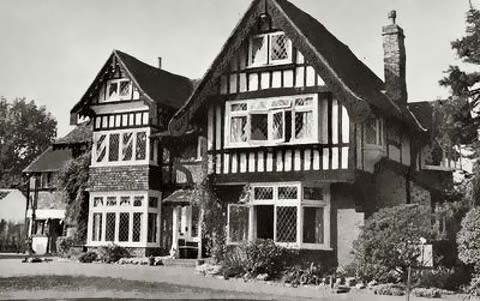
Image © The Kamera Club, 1964
The house itself
was south-east facing and was built on the former Whitehouse Farm.
Ewhurst Manor sat behind another property which was known as White House
and this building was also sat back from Furzehill Road.
It is thought to have been demolished at around the
same time as Ewhurst. The entrance to
Ewhurst Manor was via a narrow
track road that went past White House.
As had been guessed by the presence of
the willow tree seen in some shots in ITC programmes
filmed there, the garden on the Ewhurst estate sloped down to a small
pond, one of two in the grounds according
to staff at the
Elstree and
Borehamwood Museum. This is borne out by
glamour photographs that exist which show two distinct
pond areas, the second being a small fishpond edged by
a low brick wall.
The house was divided into
two distinct properties which were adjoining: the
three storey main house and the cottage. This was a two-storey
building which can be seen to the extreme left of the
top picture on this page and in close-up in the
photograph below which has been kindly supplied by
Derek Allen to Randall and Hopkirk (Declassified).
Derek's friend Jimmy Lovegrove lived in the cottage in
the 1950s and together as children, Jimmy and Derek
used to play in the garden. Today, he remembers Mrs
Clifford as being a very fastidious housekeeper – the
main house was always spotlessly clean.

1958 Photograph of the Ewhurst
Cottage
© Derek Allen,
Elstree
and Borehamwood Museum. Used with permission.
The Whitehouse
Farm estate was originally spread over 200 acres.
However, this land was gradually sold off to cover
death duties and declining wealth and by the time Alec
Clifford inherited the houses and land, it was
necessary to sell off most of the remaining land for
similar reasons. By the time that Randall and
Hopkirk (Deceased), the other ITC series and the
likes of George Harrison Marks were filming at the
house, the estate is believed to have been shrunk down
to between three and four acres only.
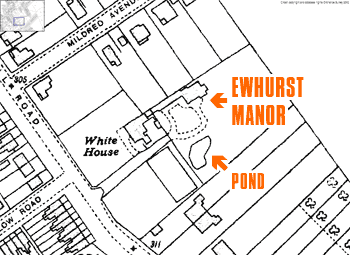 |
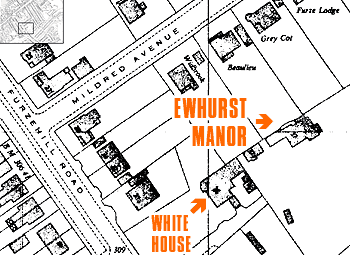 |
|
The
manor house, along with White House, is said to date
back to the 18th century and, when they were
reputedly built as
farm dwellings. This, however, is questionable
considering the grand style of Ewhurst Manor. It
seems likely to those of us at Randall and
Hopkirk (Declassified) that White House was
indeed constructed as a farm dwelling, but that
Ewhurst was actually built sometime around 1868,
when the railway came to Borehamwood. This
development caused a major change in land use in the
area, with farmland sold off due to increasing
demand and an in-flux of the affluent. It seems
highly likely that the supposed manor house was
built at this time, and that the Ewhurst Manor name
was not afforded it due to it being owned by a
member of the British nobility as the lands in the
area were owned by Baron Aldenham (whose family seat
was Aldenham House) and the Earl of Stafford
(Wrotham Park). The Ewhurst Manor name was likely a
latter-day invention, by the Cliffords or previous
owners. |
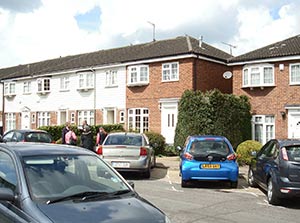
Image © Alys Hayes, 2012 |
Today,
there is nothing surviving of the Ewhurst Manor or
White House estates, bar perhaps a tree or two. A
modern housing estate now stands on the Ewhurst
Estate and the Ewhurst name has not survived, not
even down to a local road name. White House is
commemorated by Whitehouse Avenue, and part of this
road runs parallel with where the front of Ewhurst
Manor once stood and cuts through the former
location of the Ewhurst pond). The houses on Mildred
Avenue which can be seen on the maps above -
Widbrook, Beaulieu, Grey Cot and Furze Lodge - still
remain today and these properties now mark the
north-western perimeter of the housing estate built
on the site of Elstree Manor. It would appear that
the current buildings on the Ewhurst site are not
those that directly replaced it. These appear also
to have been demolished; the current buildings are
believed to date from the mid- to late-1990s.
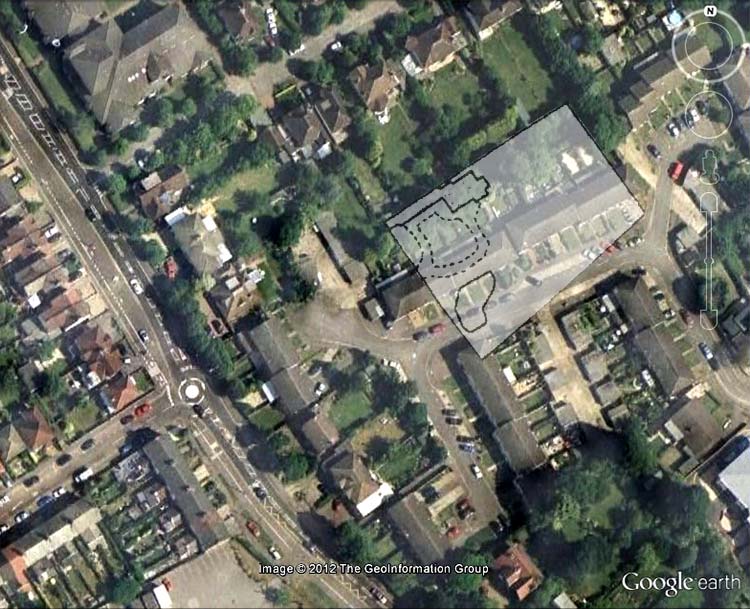
|
Image / Map Data © Google
/ The Geoinformation Group, 2012 |
| |
Following my discovery of this location in March 2012,
fans of Randall and Hopkirk (Deceased) and
other ITC series finally know where DeCrecy's stood,
something of its history (maybe too much!) and thanks
to modern technology, we can even overlay old maps on
satellite views to see precisely where it was
situated. Of course, that's not the same as seeing the
building up close, a pleasure that history has denied
us. So near and yet so far!
Feature and Research by Alan Hayes • Mapwork
by Anthony McKay
Additional Research by Rita
Hayes and Joan Street
Thanks to Derek Allen, The Elstree and Borehamwood
Museum,
Geoff Dodd,
Yahoo 60sGlam-Ewhurst Group, Gavcrimson Blog and The
Kamera Club |



